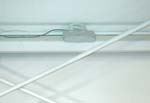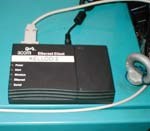On The Way To Wireless DNC
Any shop with CNC machine tools has probably wondered how a DNC system could be configured to operate with wireless network connections. Wireless systems are being installed in offices, and even in homes, so that laptops, desktop PCs, and handheld devices can communicate via e-mail, share access to the Web, and exchange data.
Share




Any shop with CNC machine tools has probably wondered how a DNC system could be configured to operate with wireless network connections. Wireless systems are being installed in offices, and even in homes, so that laptops, desktop PCs, and handheld devices can communicate via e-mail, share access to the Web, and exchange data. Why shouldn't a shop have the same convenience for sending NC programs to and from the CNCs on the shop floor?
Schunk USA's manufacturing facility in Morrisville, North Carolina, has a working DNC system that proves that such a wireless system is feasible and economically attractive. It also demonstrates the limits of current technology. The system was installed in November 2002, when Schunk expanded its U.S. manufacturing capability to produce the precision hydraulic toolholders for which the company is well known. The system uses a commercial DNC software package from CIMCO Integration (Sterling, Massachusetts) and off-the-shelf wireless network components from 3Com (Santa Clara, California).
It works like this: A DNC server (a dedicated PC) residing in the programmer's office is connected to a wireless access point, or hub, located in the ceiling above the shop floor. A standard Ethernet connection links the server and the hub. The hub act as a transceiver of radio waves beamed back and forth from the individual CNC units. A hardware device attached to the CNCs functions as the corresponding transceiver for the machine tools.
This device, an Ethernet client bridge, converts Ethernet to RS-232 input. One of these devices is plugged into the standard RS-232 serial communications port at each CNC. Operators access the DNC system as if it were hardwired to the CNC, with no difference in how the DNC interface functions. According to Jimmie Blankenship, Schunk USA's IT manager, the wireless system has been passing NC programs back and forth without a problem the entire time it has been online.
Here are some important details: The Ethernet to RS-232 converter (3Com Ethernet Client Bridge) attached to each machine is an off-the-shelf product developed for wireless networks of electronic devices with Internet protocol (IP) addresses. Mr. Blankenship, who led the research and implementation effort behind this wireless installation, believes it is the first time these devices were applied to DNC. Approximate unit cost is less than $300. (Other wireless configurations the shop first looked at required a PC at each machine, with costly "port replicators" installed as interfaces.)
Mr. Blankenship notes, however, one important caveat: As it comes out of the box, the wireless hardware does not support "drip-feed" of NC data. It can only support transfers of NC programs that "fit" in the memory of the target CNC. Mr. Blankenship and one of his programming engineers were able to work around this limitation, however.
Another key piece of enabling technology that Mr. Blankenship was able to find with the help of CIMCO Integration was a software application to run on the DNC server. This software allows the shop to assign a specific IP address on the DNC server for each of the communications ports. This capability eliminates the need for a separate serial port server and enables the system to transmit data to the correct Ethernet client bridge as a receiving device.
Two other issues had to be addressed: security and interference. Neither turned out to be obstacles. The wireless hub was designed to encrypt data at the point of transmission, and the Ethernet to RS-232 converters decode the data before the file is passed to the CNC. Because the system uses a radio frequency within a bandwidth recently dedicated to wireless networks, it is immune to interference from other sources. This concern was especially urgent because the facility is located very near a regional airport. No problems have occurred.
The wireless hub has security restrictions limiting the permissible IP addresses it will accept. For now, those addresses are assigned to the eight machines currently on the network. No new machines or network stations can be added unless a PC is physically linked to it so the system administrator can log onto the hub's operating system and change its directory of addresses. However, the wireless hub can handle as many as 64 machines if the network needs to be expanded.
Mr. Blankenship figures that conventional network cabling for the company's entire system would have cost between $12,000 and $15,000 per machine. The wireless network came in for less than $12,000 in total. Moreover, the machines can be moved at any time, and more machines can be added to the network without incurring new network expenses.
The need to drip-feed long NC programs may yet become a challenge for this shop. However, CIMCO Integration is consulting with the hardware manufacturer on ways to overcome this limitation in response to a growing interest in turnkey wireless applications and the unique challenges CNC communications present in the wireless world. The days of hardwired DNC are certainly not over, but they do appear to be numbered.
Related Content
How this Job Shop Grew Capacity Without Expanding Footprint
This shop relies on digital solutions to grow their manufacturing business. With this approach, W.A. Pfeiffer has achieved seamless end-to-end connectivity, shorter lead times and increased throughput.
Read MoreAutomated CAM Programming – Is Your Software Really Delivering?
A look at the latest automation tools in Autodesk Fusion 360 software and how forward-thinking machine shops and manufacturing departments are using them to slash delivery times and win more business.
Read MoreTips for Designing CNC Programs That Help Operators
The way a G-code program is formatted directly affects the productivity of the CNC people who use them. Design CNC programs that make CNC setup people and operators’ jobs easier.
Read MoreThe Power of Practical Demonstrations and Projects
Practical work has served Bridgerland Technical College both in preparing its current students for manufacturing jobs and in appealing to new generations of potential machinists.
Read MoreRead Next
Setting Up the Building Blocks for a Digital Factory
Woodward Inc. spent over a year developing an API to connect machines to its digital factory. Caron Engineering’s MiConnect has cut most of this process while also granting the shop greater access to machine information.
Read MoreRegistration Now Open for the Precision Machining Technology Show (PMTS) 2025
The precision machining industry’s premier event returns to Cleveland, OH, April 1-3.
Read More5 Rules of Thumb for Buying CNC Machine Tools
Use these tips to carefully plan your machine tool purchases and to avoid regretting your decision later.
Read More

































